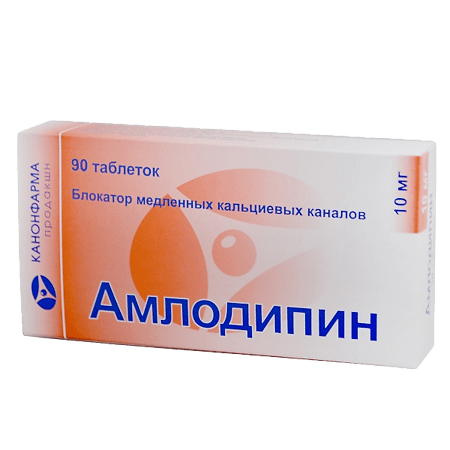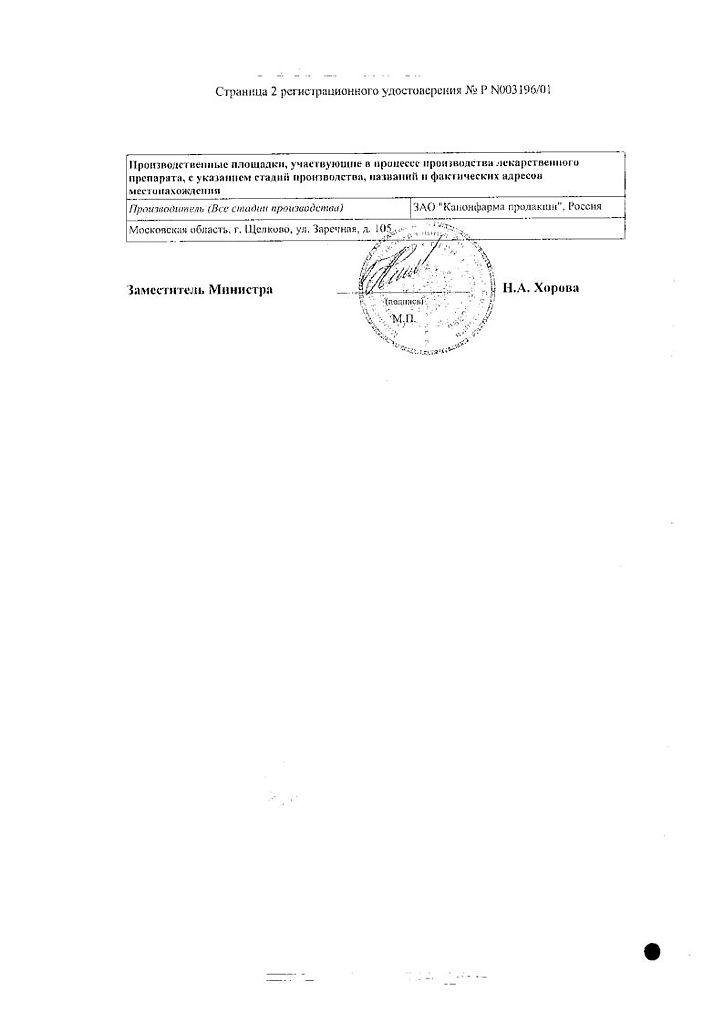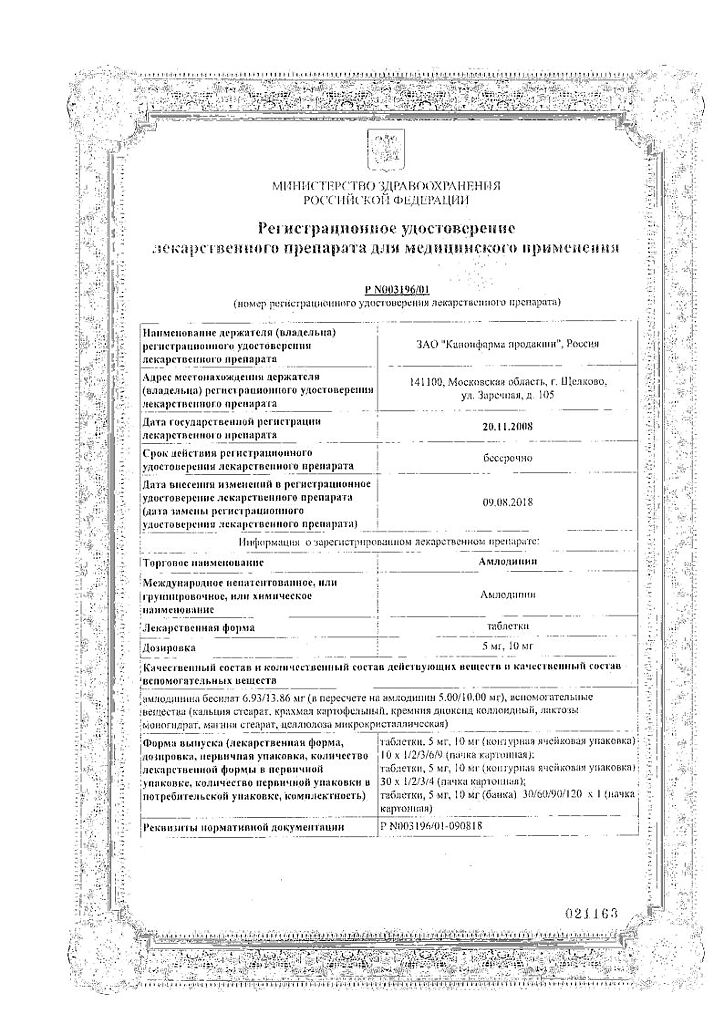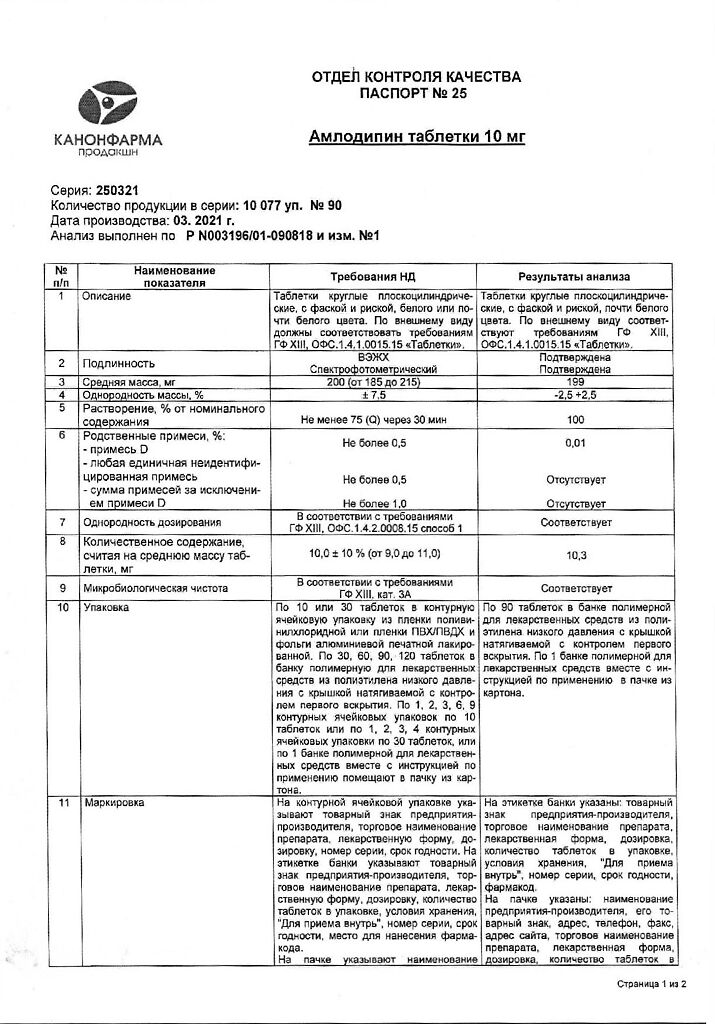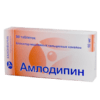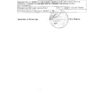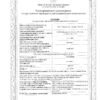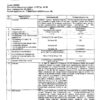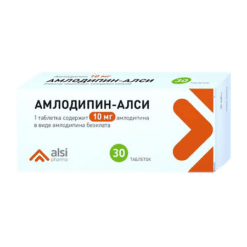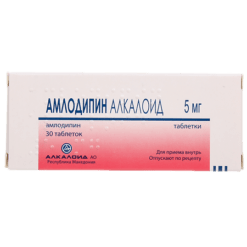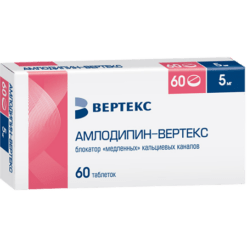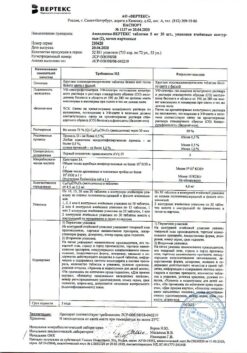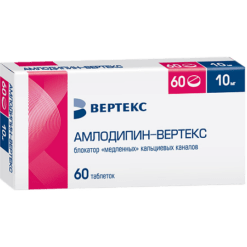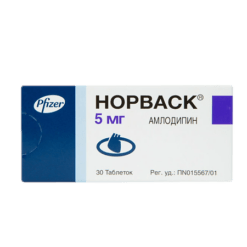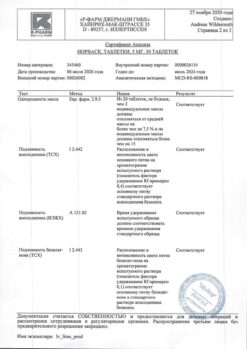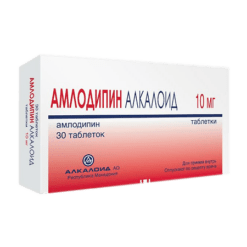No products in the cart.
Amlodipine, tablets 10 mg 90 pcs
€5.88 €5.14
Out of stock
(E-mail when Stock is available)
Description
Pharmacodynamics
Amlodipine is a dihydropyridine derivative – “slow” calcium channels blocker (BMCC) of II generation, has antianginal and hypotensive effects.
Binding to dihydropyridine receptors it blocks calcium channels, decreases transmembrane transfer of calcium ions into cell (more in vascular smooth muscle cells than in cardiomyocytes).
The antianginal action is due to the dilation of coronary and peripheral arteries and arterioles:
– in angina reduces the severity of myocardial ischemia; by dilating the peripheral arterioles, it reduces total peripheral vascular resistance; reduces the afterload on the heart, myocardial oxygen demand;
– Expands the main coronary arteries and arterioles in unchanged and ischemic areas of the myocardium, increases the flow of oxygen to the myocardium (especially in vasospastic angina); prevents the development of coronary artery spasm (including that caused by smoking).Also caused by smoking.)
In patients with stable angina a single daily dose increases exercise tolerance, delays the development of another angina attack and “ischemic” ST-segment depression; reduces the frequency of angina attacks and the consumption of nitroglycerin and other nitrates.
Amlodipine has a long-term dose-dependent hypotensive effect, which is due to a direct vasodilator effect on vascular smooth muscle. In arterial hypertension a single daily dose of amlodipine provides clinically significant reduction of arterial pressure (BP) for 24 hours (in “lying” and “standing” positions).
Orthostatic hypotension with amlodipine is rare. Amlodipine does not cause a decrease in exercise tolerance, left ventricular ejection fraction. It reduces the degree of left ventricular myocardial hypertrophy. It does not affect myocardial contractility and conduction, does not cause reflex increase in heart rate (HR), inhibits platelet aggregation, increases glomerular filtration rate, has a weak natriuretic effect.
In diabetic nephropathy it does not increase the severity of microalbuminuria. It has no adverse effect on metabolism and concentration of plasma lipids and can be used for treatment of patients with bronchial asthma, diabetes mellitus, and gout.
The time of onset of therapeutic effect is 2-4 hours, a significant decrease in BP is observed after 6-10 hours, the duration of effect is 24 hours.
In patients with cardiovascular diseases (including coronary atherosclerosis with lesions of one vessel and up to stenosis of 3 or more arteries, atherosclerosis of the carotid arteries) who have had a myocardial infarction, percutaneous transluminal coronary angioplasty (PTCA) or in patients with angina pectoris, the use of amlodipine prevents the development of carotid intima-media thickening, reduces mortality from myocardial infarction, stroke, PTCA, aortocoronary bypass; leads to fewer hospitalizations for unstable angina and progression of chronic heart failure (CHF); reduces the frequency of interventions to restore coronary blood flow.
The therapy with digoxin, diuretics and angiotensin-converting enzyme inhibitors (ACEI) does not increase mortality index or complication and lethal outcome in patients with CHF (NYHA functional class III-IV).
In patients with CHF (functional class III-IV according to NYHA classification) of non-ischemic etiology, there is a possibility of pulmonary edema when using amlodipine.
Pharmacokinetics
Intake
After oral administration, amlodipine is slowly absorbed from the gastrointestinal tract. Food intake has no effect on absorption of amlodipine. The average absolute bioavailability is 64-80%. Maximum serum concentration is observed after 6-12 hours. Equilibrium concentration is reached after 7-8 days of therapy. Simultaneous intake of food has no effect on absorption of amlodipine.
Distribution
The average volume of distribution is 21 l/kg body weight, indicating that most of the drug is in the tissues and less in the blood. Most of the drug that is in the blood (97.5%) is bound to plasma proteins.
Metabolism
Amlodipine undergoes slow but active metabolism (90-97%) in the liver with no significant “first pass” effect.
Metabolites have no significant pharmacological activity.
The elimination half-life (T1/2) after single administration varies from 35 to 50 hours. When repeatedly administered, the T1/2 is approximately – 45 hours.
About 60% of a dose taken by mouth is excreted by kidneys mainly as metabolites, 10% – as unchanged, 20-25% – in bile and through intestine as metabolites.
The total clearance of amlodipine is 0.116 ml/kg (7 ml/min/kg,0.42 l/h/kg).
The use in elderly patients
The excretion of amlodipine is slower (T1/2 – 65 h) in elderly patients (over 65 years) compared to younger patients, but this difference has no clinical significance.
The use in patients with hepatic impairment
The prolongation of the T1/2 in patients with hepatic impairment suggests that with long-term use the cumulation of the drug in the body will be higher (T1/2 – up to 60 h).
The use in patients with renal impairment
Renal impairment has no significant effect on the kinetics of amlodipine. Amlodipine penetrates through the blood-brain barrier and is not eliminated by hemodialysis.
Indications
Indications
Arterial hypertension (monotherapy or in combination with other antihypertensive drugs);
stable angina and vasospastic angina (Prinzmetal’s angina or variant angina) both in monotherapy and in combination with other antianginal drugs).
Pharmacological effect
Pharmacological effect
Pharmacodynamics
Amlodipine, a dihydropyridine derivative, is a second-generation slow calcium channel blocker (SCCC) that has antianginal and hypotensive effects.
By binding to dihydropyridine receptors, it blocks calcium channels, reduces the transmembrane transition of calcium ions into the cell (more into vascular smooth muscle cells than into cardiomyocytes).
The antianginal effect is due to the expansion of coronary and peripheral arteries and arterioles:
– in case of angina pectoris, it reduces the severity of myocardial ischemia; by expanding peripheral arterioles, reduces total peripheral vascular resistance; reduces afterload on the heart and myocardial oxygen demand;
– expands the main coronary arteries and arterioles in unchanged and ischemic areas of the myocardium, increases the supply of oxygen to the myocardium (especially with vasospastic angina); prevents the development of spasm of the coronary arteries (including those caused by smoking).
In patients with stable angina, a single daily dose increases exercise tolerance, delays the development of the next attack of angina and “ischemic” depression of the ST segment; reduces the frequency of angina attacks and the consumption of nitroglycerin and other nitrates.
Amlodipine has a long-term dose-dependent hypotensive effect, which is due to a direct vasodilating effect on vascular smooth muscle. For arterial hypertension, a single daily dose of amlodipine provides a clinically significant reduction in blood pressure (BP) over 24 hours (with the patient in the “lying” and “standing” position).
Orthostatic hypotension with amlodipine is quite rare. Amlodipine does not cause a decrease in exercise tolerance or left ventricular ejection fraction. Reduces the degree of left ventricular myocardial hypertrophy. It has no effect on myocardial contractility and conductivity, does not cause a reflex increase in heart rate (HR), inhibits platelet aggregation, increases the glomerular filtration rate, and has a weak natriuretic effect.
In diabetic nephropathy, it does not increase the severity of microalbuminuria. It does not have any adverse effect on metabolism and plasma lipid concentrations and can be used in the treatment of patients with bronchial asthma, diabetes mellitus and gout.
The time for the onset of the therapeutic effect is 2-4 hours, a significant decrease in blood pressure is observed after 6-10 hours, the duration of the effect is 24 hours.
In patients with diseases of the cardiovascular system (including coronary atherosclerosis with damage to one vessel and up to stenosis of 3 or more arteries, atherosclerosis of the carotid arteries), who have had myocardial infarction, percutaneous transluminal coronary angioplasty (PTCA) or in patients with angina pectoris, the use of amlodipine prevents the development of intima-media thickening of the carotid arteries, reduces mortality from myocardial infarction, stroke, PTCA, coronary artery bypass grafting; leads to a decrease in the number of hospitalizations for unstable angina and progression of chronic heart failure (CHF); reduces the frequency of interventions aimed at restoring coronary blood flow.
It does not increase the mortality rate or the development of complications and deaths in patients with CHF (III-IV functional class according to the NYHA classification) during therapy with digoxin, diuretics and angiotensin-converting enzyme (ACE) inhibitors.
In patients with CHF (III-IV functional class according to the NYHA classification) of non-ischemic etiology, when using amlodipine, there is a risk of pulmonary edema.
Pharmacokinetics
Suction
After oral administration, amlodipine is slowly absorbed from the gastrointestinal tract. Food intake does not affect the absorption of amlodipine. The average absolute bioavailability is 64-80%. The maximum concentration in blood serum is observed after 6-12 hours. Equilibrium concentration is achieved after 7-8 days of therapy. Concomitant food intake does not affect the absorption of amlodipine.
Distribution
The mean volume of distribution is 21 l/kg body weight, indicating that most of the drug is in the tissues and less in the blood. Most of the drug in the blood (97.5%) binds to blood plasma proteins.
Metabolism
Amlodipine undergoes slow but active metabolism (90-97%) in the liver with no significant first-pass effect.
Metabolites do not have significant pharmacological activity.
Removal
After a single dose, the half-life (T1/2) varies from 35 to 50 hours. When re-prescribed, T1/2 is approximately 45 hours.
About 60% of the dose taken orally is excreted by the kidneys mainly in the form of metabolites, 10% unchanged, 20-25% with bile and through the intestines in the form of metabolites.
The total clearance of amlodipine is 0.116 ml/s/kg (7 ml/min/kg, 0.42 l/h/kg).
Use in elderly patients
In elderly patients (over 65 years of age), the elimination of amlodipine is slower (T1/2 – 65 hours) compared to young patients, but this difference is not clinically significant.
Use in patients with liver failure
Prolongation of T1/2 in patients with liver failure suggests that with long-term use, the accumulation of the drug in the body will be higher (T1/2 – up to 60 hours).
Use in patients with renal failure
Renal failure does not significantly affect the kinetics of amlodipine. Amlodipine penetrates the blood-brain barrier and is not removed by hemodialysis.
Special instructions
Special instructions
During the treatment period, it is necessary to monitor body weight and sodium intake, and prescribe an appropriate diet.
It is necessary to maintain dental hygiene and frequent visits to the dentist (to prevent soreness, bleeding and gum hyperplasia). The dosage regimen for the elderly is the same as for patients of other age groups. When increasing the dose, careful monitoring of elderly patients is necessary.
Despite the absence of withdrawal syndrome with slow calcium channel blockers, a gradual dose reduction is recommended before stopping treatment.
Amlodipine does not affect plasma concentrations of K+, glucose, triglycerides, total cholesterol, LDL, uric acid, creatinine and uric acid nitrogen.
Impact on the ability to drive a car and operate machinery
There have been no reports of the effect of amlodipine on driving or using machinery. However, some patients may experience drowsiness and dizziness, primarily at the beginning of treatment. If they occur, the patient must take special precautions when driving and operating machinery.
Active ingredient
Active ingredient
Amlodipine
Composition
Composition
1 tablet contains:
active ingredient:
amlodipine besylate, equivalent to amlodipine 10 mg;
excipients:
calcium stearate 0.2 mg,
potato starch 38.86 mg,
colloidal silicon dioxide 1 mg,
lactose monohydrate 100 mg,
magnesium stearate 1.8 mg,
microcrystalline cellulose 44.28 mg.
Pregnancy
Pregnancy
The safety of Amlodipine during pregnancy has not been established; therefore, use during pregnancy is possible only when the benefit to the mother outweighs the risk to the fetus and newborn.
There are no data indicating the excretion of amlodipine into breast milk. However, it is known that other BMCCs, dihydropyridine derivatives, are excreted into breast milk. In this connection, if it is necessary to use the drug Amlodipine during lactation, the issue of stopping breastfeeding should be resolved.
There was no effect of amlodipine on fertility in a study in rats.
Contraindications
Contraindications
hypersensitivity to amlodipine and other dihydropyridine derivatives;
severe arterial hypotension;
collapse, cardiogenic shock;
unstable angina (except Prinzmetal angina)
pregnancy and lactation;
age under 18 years (efficacy and safety have not been established).
With caution: impaired liver function, sick sinus syndrome (severe bradycardia, tachycardia), chronic heart failure in the stage of decompensation, mild or moderate arterial hypotension, aortic stenosis, mitral stenosis, hypertrophic obstructive cardiomyopathy, acute myocardial infarction (and within 1 month after), diabetes mellitus, lipid profile disorders, old age.
Side Effects
Side Effects
WHO classification of the incidence of side effects:
very often – ≥1/10;
often – from ≥1/100 to <1/10;
uncommon – from ≥1/1000 to <1/100;
rarely – from ≥1/10000 to <1/1000;
very rare – <1/10000, including isolated reports;
frequency unknown – based on available data, it is not possible to determine the frequency of occurrence.
From the cardiovascular system:
often – palpitations, peripheral edema (swelling of the ankles and feet), flushes of blood to the skin of the face;
infrequently – excessive decrease in blood pressure;
very rarely – fainting, shortness of breath, vasculitis, orthostatic hypotension, development or worsening of chronic heart failure, cardiac arrhythmias (including bradycardia, ventricular tachycardia, atrial fibrillation), myocardial infarction, chest pain.
From the musculoskeletal system:
uncommon – arthralgia, muscle cramps, arthrosis, myalgia (with long-term use), back pain;
rarely – myasthenia.
From the central nervous system:
often – headache, dizziness, increased fatigue;
uncommon – general malaise, fainting, asthenia, hypoesthesia, paresthesia,
peripheral neuropathy, tremor, insomnia, emotional lability, unusual dreams, increased excitability, depression, anxiety, ringing in the ears, perversion of taste;
very rarely – migraine, increased sweating, apathy, agitation, ataxia, amnesia;
frequency unknown – extrapyramidal disorders.
From the digestive system:
often – nausea, abdominal pain;
uncommon – vomiting, constipation or diarrhea, flatulence, dyspepsia, anorexia, dry mouth, thirst;
rarely – gum hyperplasia, increased appetite;
very rarely – gastritis, pancreatitis, hyperbilirubinemia, jaundice (usually cholestatic), increased activity of liver transaminases, hepatitis.
From the hematopoietic organs:
very rarely – thrombocytopenia, leukopenia, thrombocytopenic purpura.
From the respiratory system:
infrequently – shortness of breath, rhinitis, nosebleeds;
very rarely – cough.
From the senses:
uncommon – diplopia, impaired accommodation, xerophthalmia, conjunctivitis, eye pain, visual impairment.
From the genitourinary system:
infrequently – frequent urination, painful urination, nocturia, erectile dysfunction;
very rarely – dysuria, polyuria.
From the skin:
rarely – dermatitis;
very rarely – cold sweat, xeroderma, alopecia, skin pigmentation disorder.
Allergic reactions:
infrequently – skin itching, rash (including erythematous, maculopapular rash, urticaria);
very rarely – angioedema, erythema multiforme.
Laboratory indicators:
very rarely – hyperglycemia.
Others:
infrequently – chills, gynecomastia, pain of unspecified localization, alopecia; very rarely – parosmia.
Interaction
Interaction
Inhibitors of microsomal oxidation increase the concentration of amlodipine in the blood plasma, increasing the risk of side effects, and inducers of microsomal liver enzymes reduce it.
The hypotensive effect is weakened by nonsteroidal anti-inflammatory drugs, especially indomethacin (sodium retention and blockade of prostaglandin synthesis by the kidneys), alpha-adrenergic agonists, estrogens (sodium retention), and sympathomimetics.
Thiazide and loop diuretics, beta-blockers, verapamil, ACE inhibitors and nitrates enhance the antianginal and hypotensive effects.
Amiodarone, quinidine, alpha 1-blockers, antipsychotic drugs (neuroleptics) and slow calcium channel blockers may enhance the hypotensive effect.
Does not affect the pharmacokinetic parameters of digoxin and warfarin.
Cimetidine does not affect the pharmacokinetics of amlodipine.
When used together with lithium drugs, it is possible to increase the manifestations of their neurotoxicity (nausea, vomiting, diarrhea, ataxia, tremor, tinnitus).
Calcium supplements may reduce the effect of slow calcium channel blockers.
Procainamide, quinidine, and other drugs known to prolong the QT interval enhance the negative inotropic effect and may increase the risk of significant QT prolongation.
Grapefruit juice may reduce the plasma concentration of amlodipine, but this decrease is so small that it does not significantly alter the effect of amlodipine.
Overdose
Overdose
Symptoms: marked decrease in blood pressure, tachycardia, excessive peripheral vasodilation..
Treatment: gastric lavage, administration of activated charcoal, maintaining the function of the cardiovascular system, monitoring indicators of heart and lung function, elevated position of the extremities, monitoring the volume of circulating blood and diuresis. To restore vascular tone, use vasoconstrictor drugs (in the absence of contraindications to their use); to eliminate the consequences of blockade of calcium channels – intravenous administration of calcium gluconate. Hemodialysis is not effective.
Storage conditions
Storage conditions
Store at a temperature not exceeding 25°C.
Shelf life
Shelf life
5 years.
Manufacturer
Manufacturer
Kanonpharma production CJSC, Russia
Additional information
| Shelf life | 5 years. |
|---|---|
| Conditions of storage | Store at a temperature not exceeding 25 ° C. |
| Manufacturer | Kanonfarma Production ZAO, Russia |
| Medication form | pills |
| Brand | Kanonfarma Production ZAO |
Other forms…
Related products
Buy Amlodipine, tablets 10 mg 90 pcs with delivery to USA, UK, Europe and over 120 other countries.

